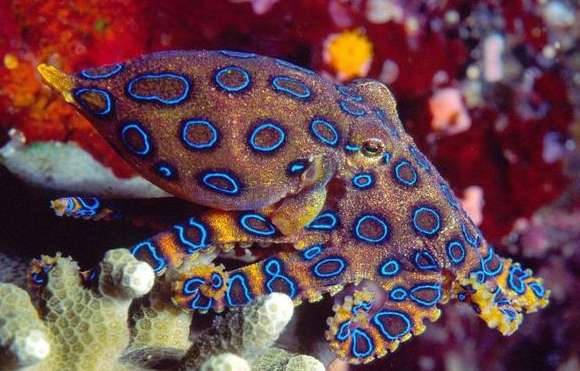Everyone is familiar with the blue-ringed octopus, right? There are many accounts on the Internet that like to rank animals. They say that the blue-ringed octopus must have toxins, and it is among the top ones. They are really right about this. The tetrodotoxin in the blue-ringed octopus is indeed very dangerous. A while ago, there was news in our country that someone discovered that blue-ringed octopus was served as a dish while eating hot pot, which caused a lot of uproar at the time.

The so-called blue ring There are actually four species of octopus: the great blue-ringed octopus (Hapalochlaena lunulata), the southern blue-ringed octopus, and the blue-striped octopus (Hapolochlaena maculosa). They are all very small, with the largest individual's arm span less than 15 centimeters, and can be completely placed in the palm of our hands.
Blue-ringed octopuses are very gorgeous. Their bodies will shine with this blue halo, which is naturally a warning to predators: I am highly poisonous! These halos are the result of tiny color-changing organs called chromatophores scattered throughout their bodies.
The toxin in the blue-ringed octopus belongs to tetrodotoxin. This toxin is more like a "chicken thief". It does not cause damage directly, but blocks the sodium ion channel to prevent the nerves from sending signals to the muscles. This will It leads to muscle paralysis and soon stops working, leaving you unable to move much. The most terrifying thing is that these paralyzed muscles include respiratory muscles! This can cause a person to be unable to breathe and eventually suffocate.

According to the U.S. Disease Control and Prevention According to the Centers for Disease Control and Prevention (CDC), the onset time of tetrodotoxin is not fixed. It may occur very quickly, or it may be delayed to 20 minutes to 24 hours. In short, if you are poisoned, go to the doctor immediately. In addition, the blue-ringed octopus itself cannot actually produce tetrodotoxin. Their toxin is produced by symbiotic bacteria living in its salivary glands. Although the symbiotic bacteria live here, the toxin is dispersed into various tissues of the blue-ringed octopus. So even just touching them can cause poisoning.
There is currently no known antidote for tetrodotoxin.
Woman was bitten multiple times by a blue-ringed octopus
Last month, an Australian woman was bitten three times by a blue-ringed octopus, but she survived He didn't even suffer much pain.
At that time, this woman was swimming near Sydney, New South Wales, Australia. She had excellent water skills. While swimming, she was picking up shells on the seabed in the offshore sea. When she got tired, the woman carried the shells ashore. rest. She lay on the armchair, picked up the shells and looked at them carefully. A small cephalopod fell out of one of the shells, and it happened to fall on her belly.
A slight pain came, and the woman looked down.

"Ouch! This is Is it a blue-ringed octopus? It’s over!"
 < /p>
< /p>
She immediately called the police, and the New South Wales ambulance rushed to the hospital and sent her to the hospital for symptom monitoring, but strangely, the woman finally recovered after only receiving cold compress treatment, which made the doctors feel strangeness. It's unclear how the woman escaped the blue-ringed octopus venom unharmed.
Lucky Woman
Although the blue-ringed octopus is very poisonous, it has only caused three cases so far fatal accident. However, no one has ever been able to escape danger as easily as this Australian woman. Basically, the hospital needs to provide supportive care. When the patient cannot breathe, a ventilator is used and appropriate medicine is always given according to the victim's condition. Even if he does not die, he still suffers. A long time.
It is speculated that the blue-ringed octopus that bit the woman may not have a lot of toxins in its body, so the three bites did not inject much toxins. In addition, the belly is the fattest area, which may be able to withstand some of the toxins. ?

In short, this is indeed very lucky.